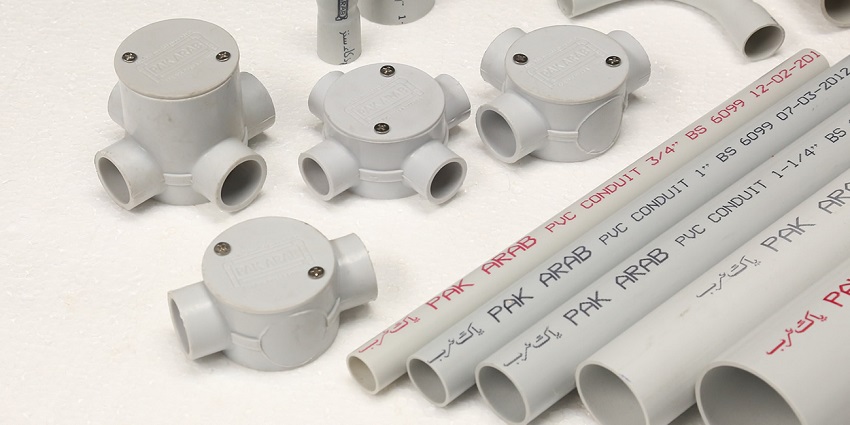What is a conduit pipe? Conduit pipes protect and route electrical wires, coming in different sizes and types made of steel, aluminum, or plastic. They shield wires and are vital for electrical system safety. Categorized as metal or non-metallic, each has unique benefits and drawbacks. Mostly used in commercial and industrial applications.
Have you ever thought about what keeps electrical wiring safe from damage? Enter conduit pipes – the most crucial part of the electrical world!
In this article, we will explore everything you need to know about conduit pipes, including their types, uses, installation procedures, and maintenance requirements.
What Is A Conduit Pipe?
A conduit pipe is a tough tube that protects electrical wiring. It comes in different sizes and materials like steel, PVC, or fiberglass. It’s used in construction projects to shield the wiring from damage caused by moisture, physical impact, and electromagnetic fields.
In other words, this pipe is a silent guardian that stands tall to protect the electrical system from harmful elements. This makes it an overlooked but necessary item that keeps our modern world running.
What Are the Types of Materials Commonly Used to Make Conduit Pipes?
Conduit pipes are typically fabricated using various materials depending on the specific intended application and use. Among the most commonly utilized materials for conduit pipes are:
- PVC (Polyvinyl Chloride): This is a plastic material that is lightweight, flexible, and resistant to corrosion.
- Fiberglass: Fiberglass is a reinforced plastic material made from small glass fibers.
- Fired Clay: Clay that has been molded into a desired form and subsequently exposed to high temperatures.
- Galvanized Steel: Galvanized steel refers to steel that has been coated with a layer of zinc. It’s corrosion-resistant.
- Aluminum: Highly versatile and adaptable metal due to its lightweight nature.
- Stainless Steel: Steel alloy containing at least 10.5% chromium and highly resistant to corrosion.
- EMT (Electrical Metallic Tubing): Made up of this walled steel, its lightweight conduit is used to protect and route electrical wiring.
Other materials can be used to make conduit pipes. However, these are the most commonly used ones
Why Should You Use Conduit for Electrical Wiring?
Using a conduit is a practical solution for running electrical wiring in residential, commercial, and industrial settings. It’s a smart choice for several reasons.
- Durability: Conduit pipe is durable. This is ideal for protecting wiring in areas that are exposed to harsh conditions.
- Organized: Conduit provides a structured arrangement for wire placement, especially in large-scale installations. This is how the wire can be traced easily.
- Protection: By encasing electrical wiring in a protective layer, conduit helps safeguard it from damage.
- Flexibility: Not all the materials but PVC and FMC can easily be bent when necessary.
- Maintenance: The process of installing and removing conduit pipes is straightforward. However, maintaining them is generally uncomplicated.
How To Choose an Electrical Conduit?
When you are considering purchasing conduit pipes for your commercial or residential property. Don’t forget to follow the guidelines set forth by the National Electrical Code (NEC) or local codes.
These guidelines provide an ideal requirement that will ensure the efficient operation of your electrical system. Additionally, it will guarantee your safety and security
Check the Material
There are two main types of conduits available: metallic and non-metallic. If ensuring safety and security is your top priority, opt for the metal conduit. It provides 100% durability and protects your electrical wiring from physical damage or corrosive environments.
Consider Location
When choosing an electrical conduit, consider the installation location. PVC conduit is a good choice for indoor locations without the risk of damage.
Weight
Consider the weight of the electrical conduit, especially if it’s installed in a location where weight, is a concern. PVC or aluminum conduits can be a better option to reduce load and strain.
Follow the code
Ensure the electrical conduit you choose complies with local building codes and regulations to guarantee safety and efficiency and avoid potential hazards. Consulting with a licensed electrician can help ensure compliance with all necessary requirements.
Advantage And Disadvantage Of Conduit Pipe
Here are a few advantages and drawbacks of conduit pipes. This will illustrate the potential benefits and limitations of using conduit pipes.
Advantages
- Repairing and maintenance are very affordable and easy
- When the metal conduit is properly grounded, it eliminates the risk of electric shock in this type of wiring
- Extremely long-lasting
- Reusable
Disadvantages
- Occupy more space compared to other types of pipes or hidden electronic protectors
- Conduit’s weight and bulk can make it challenging to install in some places
Where Can Conduit Pipe Be Used?
Conduit pipe can be used in a wide variety of situations. The following are some examples of appropriate uses for conduit pipes.
- Residential buildings: Conduit pipes can be used to protect wiring and reduce fire hazards in homes.
- Commercial and industrial buildings: Conduit pipes are suitable for high-traffic areas and harsh environments. This protects electrical systems from damage.
- Power generation and distribution facilities: Conduit pipes are used in power generation and distribution facilities to prevent electrical hazards. And this ensures compliance with safety standards.
- Telecommunications and data centers: Conduit pipes are used to protect critical communication and data systems from physical damage and environmental factors.
- Media houses: Conduit pipes can help media houses to manage their complex cabling systems. Thus, it ensures the safety and reliability of their broadcasting equipment.
- Medical facilities where grounding and safety are critical: Conduit pipes can protect electrical systems and ensure reliable grounding. This is how it reduces the risk of electrical shocks and maintains a safe environment for medical staff and patients.
Frequently Asked Questions
If you are looking for more information on conduit pipes, read these questions and answers related to this topic.
Q: What is the difference between conduit and pipe?
Conduits and pipes have different purposes. Conduits protect and route electrical wiring, while pipes transport fluids or gasses. Conduits have thicker walls and different materials than pipes to prevent damage.
Pipes, on the other hand, are designed to withstand pressure and are made of materials like copper, steel, PVC, or cast iron.
Q: What is the alternative to conduit?
An alternative to using electrical conduits is to use wireless or powerline communication systems. These solutions can eliminate the need for physical wiring and conduits, making installation and modifications easier and more cost-effective.
However, limitations such as signal interference and reliability issues should be considered.
Q: In which scenarios should conduit pipes not be used?
Conduit pipes can’t handle high temperatures (Usually its 204°C for metal and 60°C for PVC) and can deform or melt. They may also corrode in certain environments. Before using them, it’s important to check if they’re suitable for the specific conditions of the electrical system.
Final Words
Conduit pipes protect electrical wiring and cables from hazards like physical damage and moisture in commercial and industrial settings.
They can be more expensive and complex to install but offer benefits like safety, organization, and easier maintenance. So, even though they may not be flashy, conduit pipes are essential for keeping our electrical systems safe and functional.

